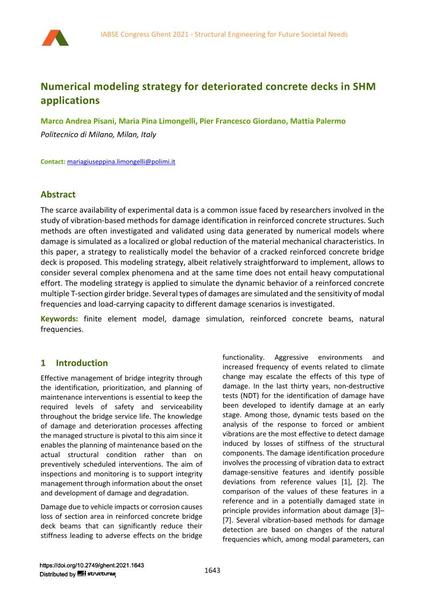Numerical modeling strategy for deteriorated concrete decks in SHM applications

|
|
|||||||||||
Détails bibliographiques
| Auteur(s): |
Marco Andrea Pisani
(Politecnico di Milano, Milan, Italy)
Maria Pina Limongelli (Politecnico di Milano, Milan, Italy) Pier Francesco Giordano (Politecnico di Milano, Milan, Italy) Mattia Palermo (Politecnico di Milano, Milan, Italy) |
||||
|---|---|---|---|---|---|
| Médium: | papier de conférence | ||||
| Langue(s): | anglais | ||||
| Conférence: | IABSE Congress: Structural Engineering for Future Societal Needs, Ghent, Belgium, 22-24 September 2021 | ||||
| Publié dans: | IABSE Congress Ghent 2021 | ||||
|
|||||
| Page(s): | 1643-1650 | ||||
| Nombre total de pages (du PDF): | 8 | ||||
| DOI: | 10.2749/ghent.2021.1643 | ||||
| Abstrait: |
The scarce availability of experimental data is a common issue faced by researchers involved in the study of vibration-based methods for damage identification in reinforced concrete structures. Such methods are often investigated and validated using data generated by numerical models where damage is simulated as a localized or global reduction of the material mechanical characteristics. In this paper, a strategy to realistically model the behavior of a cracked reinforced concrete bridge deck is proposed. This modeling strategy, albeit relatively straightforward to implement, allows to consider several complex phenomena and at the same time does not entail heavy computational effort. The modeling strategy is applied to simulate the dynamic behavior of a reinforced concrete multiple T-section girder bridge. Several types of damages are simulated and the sensitivity of modal frequencies and load-carrying capacity to different damage scenarios is investigated. |
||||
| Copyright: | © 2021 International Association for Bridge and Structural Engineering (IABSE) | ||||
| License: | Cette oeuvre ne peut être utilisée sans la permission de l'auteur ou détenteur des droits. |
||||
